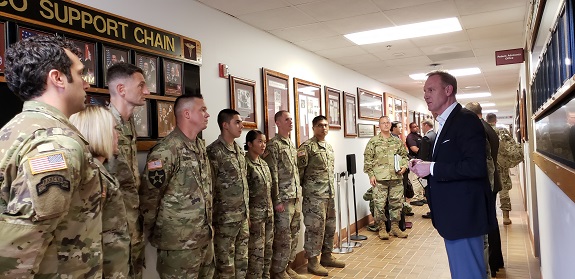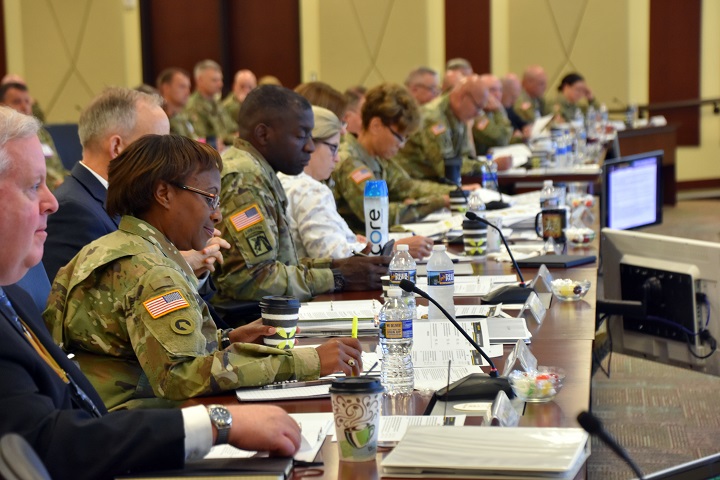
Shanahan discusses medical readiness, DHA transfer at Womack

Deputy Defense Secretary Patrick M. Shanahan greets Veterans Affairs Secretary Robert Wilkie as Army Col. John Melton, the commander of Womack Army Medical Center, looks on, at the start of a meeting at Womack Army Medical Center, Fort Bragg, North Carolina, July 26, 2018. Shanahan convened the meeting to discuss medical readiness, as well as how the Defense Health Agency and military services are collaborating on the integration of the Military Health System. (DoD photo by Lisa Ferdinando)
FORT BRAGG, N.C. — Deputy Defense Secretary Patrick M. Shanahan visited Womack Army Medical Center here July 26 for an update on how the Defense Health Agency and the military services are collaborating on the integration of the Military Health System.
"We don't want to hear about how well things are going,” Shanahan said in an interview after the visit. “We really want to understand: ‘What are the things that are issues?”
Shanahan said he wants to "kick the tires, if you will, and talk to the people who are going to do the implementation, and discuss day one readiness” to ensure problems are mitigated and the proper resources are in place when the first phase of the transition begins Oct. 1.
The fiscal year 2017 National Defense Authorization Act transfers the administration and management of military medical treatment facilities to the DHA beginning Oct. 1, 2018. It will be done in phases, and Womack Army Medical Center is included in the first wave of transfers.

Deputy Defense Secretary Patrick M. Shanahan talks to staff at Womack Army Medical Center, Fort Bragg, North Carolina, July 26, 2018. Shanahan met with military health officials to discuss Army medical readiness, as well as the transfer of administration and management of military medical treatment facilities to the Defense Health Agency beginning Oct. 1, 2018. (DoD photo by Lisa Ferdinando)
Supporting National Defense Strategy
The transition of the administration and management of the military medical treatment facilities, Shanahan explained, will increase readiness and patient care, as well as focus on affordability. It supports two lines of effort in the National Defense Strategy: increasing lethality and reforming the department for greater performance and affordability, he said.
For example, with DHA taking on those responsibilities, the military services can better attend to the medical readiness of their members.
The best practices of DHA will help boost productivity and morale, the secretary said, explaining a further benefit is the cost and security aspect of being under one DoD agency.
Discussions on Medical Readiness
Shanahan said the topics of discussion at Womack included Army medical readiness, and how to fill any gaps in order to generate a higher state of readiness. He said they also discussed the deployments of medical professionals, and balancing the needs of the service with the needs of the medical facilities where the professionals are stationed.
Participants in the Womack meeting included: Navy Vice Adm. Raquel Bono, the DHA director; Robert Wilkie, the Secretary of the Department of Veterans Affairs; Thomas McCaffery, the acting assistant secretary of defense for health affairs; Army Lt. Gen. Nadja West, the Army’s Surgeon General; Army Lt. Gen. Paul LaCamera, commander of the XVIII Airborne Corps and Fort Bragg; Army Gen. Robert Abrams, commander of U.S. Army Forces Command, Fort Bragg; and Army Col. John Melton, commander of the Womack Army Medical Center.
Shanahan said the Womack talks will be followed up in six weeks with a meeting on the status of the transition, to include topics of procurement, and the workflow in implementing the new electronic health records system.
Disclaimer: Re-published content may have been edited for length and clarity. Read original post.
Trauma care reference body now woven into DHA combat support
Article
8/3/2018

The JTS mission is to provide evidence-based process improvement of trauma and combat casualty care to drive morbidity and mortality to the lowest possible levels, and to provide recommendations on trauma care and trauma systems across the Military Health System
NMC Camp Lejeune: 75 years of service expands to civilian community
Article
7/31/2018

Trauma verification helps providers keep skills sharp
Leaders come together to rehearse military healthcare transition
Article
7/31/2018

There should be zero impact on delivery of medical services that support readiness of the force
Acute Injuries
Infographic
7/25/2018

Service members in the U.S. Armed Forces frequently engage in high levels of physical activity to perform their duties, and such activity can potentially result in training- or duty-related injury. This report summarizes the incidence, trends, types, external causes, and dispositions of acute injuries among active component U.S. service members over ...
Food Allergy
Infographic
7/25/2018

Individuals with a history of food-allergy anaphylaxis or a systemic reaction to food do not meet military accession or retention standards and require a waiver in order to serve in the military. First-line treatment for anaphylaxis includes rapid administration of epinephrine.
Preparing for travel can prevent illness
Article
7/17/2018

Experts encourage travelers to be proactive about their travel medicine needs, including learning about the health risks associated with the destination and checking with their doctor to make sure they’re in good health
Department of Defense Midseason Vaccine Effectiveness Estimates for the 2017-2018 Season, U.S. Armed Forces, 2000–2015 Vaccine Effectiveness
Infographic
7/3/2018

Operation Bobcat provides free healthcare to residents of Eastern Kentucky
Article
7/2/2018

The primary purpose of Operation Bobcat is to provide military medical troops with crucial training
DHA PI 6025.07: Naloxone in the MTFs
Policy
This Defense Health Agency-Procedural Instruction (DHA-PI), based on the authority of References (a) through (c), and in accordance with the guidance of References (d) through (h), establishes the Defense Health Agency’s (DHA) procedures for prescribing and dispensing naloxone by pharmacists in MTFs to eligible beneficiaries, upon beneficiary request, or when the pharmacist determines the beneficiary meets the established criteria for being at risk for a life-threatening opiate overdose.
- Identification #: DHA PI 6025.07
- Date: 6/19/2018
- Type: DHA Procedural Instruction
- Topics: Health Readiness | TRICARE Pharmacy Program
Two MHS providers achieve top scores in the patient experience survey
Article
6/4/2018

The MHS recently published its annual “Best of the Best” report on medical providers
Project Sea Raven delivers cutting-edge pathogen detection technology
Article
5/31/2018

Project Sea Raven is now an integral part of USNS Mercy’s microbiology capacity
Hospitalizations, Active Component, U.S. Armed Forces, 2017
Infographic
5/23/2018

This report documents the frequencies, rates, trends, and distributions of hospitalizations of active component members of the U.S. Army, Navy, Air Force, and Marine Corps during calendar year 2017.
Morbidity Burdens Attributable to Various Illnesses and Injuries
Infographic
5/23/2018

Morbidity Burdens Attributable to Various Illnesses and Injuries, Deployed Active and Reserve Component Service Member, U.S. Armed Forces, 2017
Morbidity Burdens Attributable to Various Illnesses and Injuries, Deployed Active and Reserve Component Service Member, U.S. Armed Forces, 2017
Infographic
5/23/2018

Ambulatory Visits, Active Component, U.S. Armed Forces, 2017
Infographic
5/23/2018

ACTIVE COMPONENT, U.S. ARMED FORCES, 2017 This report documents the frequencies, rates, trends, and characteristics of ambulatory healthcare visits of active component members of the U.S. Army, Navy, Air Force, and Marine Corps.





















.png)









No hay comentarios:
Publicar un comentario